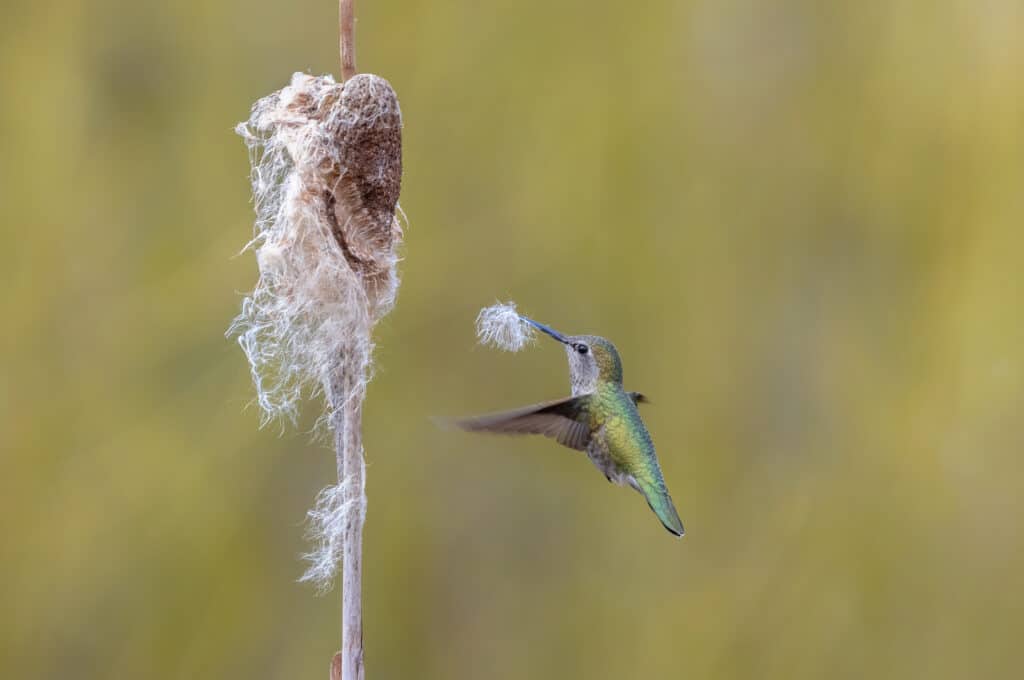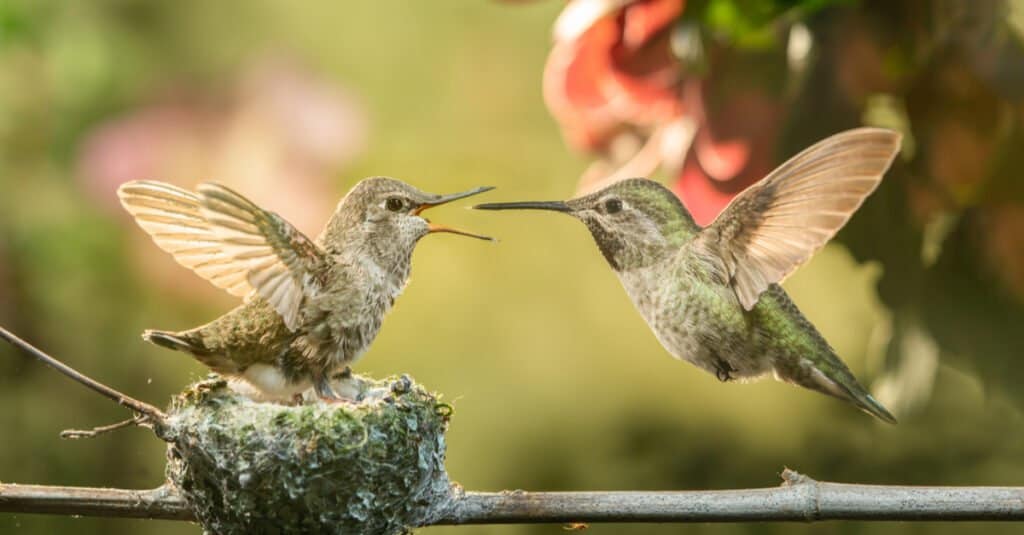Before we dive into where hummingbirds nest, let’s first take a closer look at these amazing creatures. Hummingbirds are small, colorful birds known for their incredible ability to hover in mid-air by fluttering their wings up to 80 times in one second. They have long, thin beaks that allow them to reach deep into flowers and extract nectar with ease.
In terms of appearance, hummingbirds come in a variety of colors and patterns depending on the species. Some common colors include green, red, blue, and purple. Their feathers are incredibly soft and iridescent, giving them a stunning shimmering effect when they fly through the sunlight. Overall, hummingbirds are truly remarkable birds that captivate us with their unique abilities and beautiful appearances.
Where Do Hummingbirds Nest?
Hummingbirds are known for their unique nesting habits, and females are responsible for building their nests. These tiny birds typically build their nests on slender branches, which often descend from deciduous trees like hornbeam, oak, birch, poplar, or hackberry. However, sometimes they can also be found nesting in pine trees.
The height at which hummingbird nests are built is also noteworthy, as they usually prefer to nest 10-40 feet above the ground. This provides them with a safe distance from predators that could harm their offspring.
Interestingly enough, hummingbirds have been known to build their nests in unconventional locations, such as loops of chains or wire and even extension cords! They seem to be quite adaptable when it comes to finding ideal spots for nesting.
Overall, knowing where hummingbirds nest can help birdwatchers spot these beautiful creatures more easily during the breeding season. Understanding how they adapt and survive in different environments only adds to our appreciation of these fascinating birds.
Nest Material and Construction
Hummingbirds are known for their agile flight, vibrant colors, and unique characteristics. One of the most intriguing aspects of hummingbirds is their nesting behavior. Unlike other birds that build nests in a fork or crevice, hummingbirds prefer to build their nests directly on top of a branch.
The nest construction process takes approximately 6-10 days and results in a small structure measuring only about 2 inches across and 1 inch deep. However, despite their compact size, these tiny structures provide safety and comfort to hummingbird chicks during their early stages of life.
To create this perfect little home for her young ones, the female hummingbird uses thistle or dandelion down held together by strands of spider silk. She may also use pine resin as an adhesive agent to help hold everything together more securely.
Once the basic structure is complete, the female hummer will stamp on the base of the nest to stiffen it up while leaving enough flexibility for future growth. The walls remain pliable so they can expand as needed when chicks begin hatching from eggs laid inside.
During nest construction, she further shapes it by pressing and smoothing it between her neck and chest using gentle movements until she achieves a rim that’s perfectly shaped for holding her precious cargo.
To finish off this work-of-art-like creation even further — which serves as both a safe haven and nursery for her babies — bits of lichen or moss are delicately placed outside around its perimeter, likely serving as camouflage against natural predators.

©Devonyu /Shutterstock.com
Baby Hummingbirds
Baby is not the correct term, really, as newly born birds are actually called hatchlings, chicks, or nestlings. But still, can you imagine anything cuter than a newborn hummingbird?
Baby hummingbirds emerge from their eggs with their eyes shut and almost no feathers. Their skin is either pink or grey, and they are very tiny, normally lighter than a dime. Their feet are so small that they cannot stand, making them completely reliant on their mothers for food and heat. It usually takes about three weeks for the chicks to acquire a full set of feathers.
Human babies need a high-protein diet and nectar to grow up healthy. In the same way, hummingbird chicks need an abundance of insects and nectar for their rapid development and to develop strong bones and beaks. The mother will provide these nutrients to her young multiple times per day by regurgitating food into their mouths. The mother will keep feeding them until they are around one month old, or even up to 60 days in some tropical hummingbirds. After that, they are on their own.
Taking Flight
Hummingbirds are known for their incredible flying abilities, and it turns out that they start honing those skills at a very young age. Baby hummingbirds begin exercising their wings when they are just two weeks old in preparation for their first flights. This is an important milestone in the life of a baby hummingbird as it marks the beginning of its journey toward independence.
Once baby hummingbirds are ready to fly, they leave the nest in a process called fledging. Fledging can be a dangerous time for baby birds as they have yet to master their flying abilities fully and may make mistakes that could put them at risk. However, with practice and persistence, most baby hummingbirds will quickly become adept flyers.
Incredibly, within just one month (or up to two months for some tropical types) after hatching, these tiny birds become completely independent from their parents. They no longer rely on them for food or protection and instead must fend for themselves in the wild.
For migratory species of hummingbirds like the Ruby-throated Hummingbird that breed in North America but winter in Central America or Mexico, this newfound independence means preparing themselves for an epic journey southward. These young birds must find enough food along the way to fuel their long flight while avoiding predators and adverse weather conditions.
Overall, while watching adult hummingbirds dart around your garden can be entertaining enough by itself, knowing what goes into raising these amazing creatures should give you even more appreciation of how remarkable these little birds truly are.

©Freebilly Photography/Shutterstock.com
When To See Them
Hummingbirds typically have their babies during the spring and summer months, when flowers are in bloom, and there is an abundance of nectar for them to feed on. The nesting season can vary depending on the species of hummingbird and their geographic location, but it generally begins in March or April and lasts until August or September.
If you’re hoping to spot a hummingbird chick, keep an eye out for nests that are located high up in trees or shrubs. Female hummingbirds construct their tiny nests using materials such as spider webs, plant fibers, and moss. They may lay anywhere from one to three eggs at a time, which hatches after about two weeks.
Overall, if you want to see baby hummingbirds in action, your best bet is to keep an eye out during the spring and summer months when these tiny birds are actively nesting and raising their young!
Where To See Them
Hummingbirds are some of the most fascinating birds in North America, and they can be found in many US States. However, there are also places where these delightful creatures do not exist at all. So which US States have hummingbirds? The answer is that almost every state has them! Hummingbirds live across much of the continent, from Alaska to Florida and even parts of Canada.
However, it’s worth noting that while many states may have hummingbirds visiting their gardens or parks during migration season, only a few provide permanent nesting habitats for these tiny birds. Some states with high populations of hummingbirds include Arizona (with 18 different species!), California (14), Texas (20), New Mexico (17), and Florida (12).
On the other hand, there is one US State where no hummingbird species have been recorded at all – Hawaii. Alaska, Kentucky, and Maine have four types of hummingbirds, Indiana has 3, New Hampshire and Vermont have 2, and North Dakota and Rhode Island are only home to the ruby-throated hummingbird.
Whether you’re an avid birdwatcher looking to spot a new species or just curious about nature’s wonders around you – knowing where hummingbirds nest can be helpful when planning your next birding trip!
The post Where Do Hummingbirds Nest? appeared first on AZ Animals.
from Animal News, Facts, Rankings, and More! - AZ Animals https://ift.tt/19Vc68Q